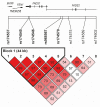FADS Polymorphisms Affect the Clinical and Biochemical Phenotypes of Metabolic Syndrome
- PMID: 35736500
- PMCID: PMC9228863
- DOI: 10.3390/metabo12060568
FADS Polymorphisms Affect the Clinical and Biochemical Phenotypes of Metabolic Syndrome
Abstract
Long-chain polyunsaturated fatty acids (LC-PUFAs) play important roles in human health, from controlling inflammation to lipid and glucose homeostasis. In our previous study, which employed a cluster analysis of a plasma fatty acid (FA) pattern, we identified two clusters of metabolic syndrome (MetS) independent of clinical and biochemical parameters within the whole study group (controls together with metabolic syndrome (MetS) patients). FA desaturase (FADS) genes are the key regulators of LC-PUFA metabolism. The aim of this study was to analyze associations between FADS polymorphisms and clusters of MetS. The study group consisted of 188 controls and 166 patients with MetS. The first cluster contained 71 controls (CON1) and 109 MetS patients (MetS1). The second cluster consisted of 117 controls (CON2) and 57 MetS patients (MetS2). In comparison with MetS2, cluster MetS1 displayed a more adverse risk profile. Cluster CON1 had, in comparison with CON2, higher body weight and increased triacylglycerol levels (p < 0.05). We found that the FADS rs174537 (p < 0.001), rs174570 (p < 0.01), and rs174602 (p < 0.05) polymorphisms along with two inferred haplotypes had statistically significant genotype associations with the splitting of MetS into MetS1 and MetS2. Conversely, we observed no significant differences in the distribution of FADS polymorphisms between MetS and CON subjects, or between CON1 and CON2. These associations between FADS polymorphisms and two clusters of MetS (differing in waist circumference, HOMA-IR, lipolysis, and oxidative stress) implicate the important influence of genetic factors on the phenotypic manifestation of MetS.
Keywords: FADS1; FADS2; cluster analysis; fatty acid pattern; haplotypes; metabolic syndrome; single-nucleotide polymorphism.
Conflict of interest statement
The authors declare no conflict of interest.
Figures
Similar articles
-
Erythrocyte polyunsaturated fatty acid composition is associated with depression and FADS genotype in Caucasians.Nutr Neurosci. 2018 Oct;21(8):589-601. doi: 10.1080/1028415X.2017.1327685. Epub 2017 May 29. Nutr Neurosci. 2018. PMID: 28552045
-
The combined effects of FADS gene variation and dietary fats in obesity-related traits in a population from the far north of Sweden: the GLACIER Study.Int J Obes (Lond). 2019 Apr;43(4):808-820. doi: 10.1038/s41366-018-0112-3. Epub 2018 May 24. Int J Obes (Lond). 2019. PMID: 29795460 Free PMC article.
-
Allele-specific methylation in the FADS genomic region in DNA from human saliva, CD4+ cells, and total leukocytes.Clin Epigenetics. 2018 Apr 6;10:46. doi: 10.1186/s13148-018-0480-5. eCollection 2018. Clin Epigenetics. 2018. PMID: 29636834 Free PMC article.
-
Genetic variants of the FADS1 FADS2 gene cluster as related to essential fatty acid metabolism.Curr Opin Lipidol. 2010 Feb;21(1):64-9. doi: 10.1097/MOL.0b013e3283327ca8. Curr Opin Lipidol. 2010. PMID: 19809313 Review.
-
Do FADS genotypes enhance our knowledge about fatty acid related phenotypes?Clin Nutr. 2010 Jun;29(3):277-87. doi: 10.1016/j.clnu.2009.11.005. Epub 2009 Nov 30. Clin Nutr. 2010. PMID: 19948371 Review.
Cited by
-
Association between omega-3 index and depersonalization among healthcare workers in a university hospital: a cross-sectional study.Front Psychiatry. 2024 Nov 15;15:1425792. doi: 10.3389/fpsyt.2024.1425792. eCollection 2024. Front Psychiatry. 2024. PMID: 39619337 Free PMC article.
-
Influence of Fatty Acid Desaturase Enzyme-1 Gene (FADS-1) Polymorphism on Serum Polyunsaturated Fatty Acids Levels, Desaturase Enzymes, Lipid Profile, and Glycemic Control Parameters in Newly Diagnosed Diabetic Mellitus Patients.Int J Mol Sci. 2025 Apr 24;26(9):4015. doi: 10.3390/ijms26094015. Int J Mol Sci. 2025. PMID: 40362254 Free PMC article.
-
Effect of FADS1 SNPs rs174546, rs174547 and rs174550 on blood fatty acid profiles and plasma free oxylipins.Front Nutr. 2024 Jul 3;11:1356986. doi: 10.3389/fnut.2024.1356986. eCollection 2024. Front Nutr. 2024. PMID: 39021601 Free PMC article.
-
Omega-3 index as risk factor in psychiatric diseases: a narrative review.Front Psychiatry. 2023 Jul 28;14:1200403. doi: 10.3389/fpsyt.2023.1200403. eCollection 2023. Front Psychiatry. 2023. PMID: 37575565 Free PMC article. Review.
-
Genetic association between FADS and ELOVL polymorphisms and the circulating levels of EPA/DHA in humans: a scoping review.Genes Nutr. 2024 Jun 6;19(1):11. doi: 10.1186/s12263-024-00747-4. Genes Nutr. 2024. PMID: 38844860 Free PMC article.
References
Grants and funding
LinkOut - more resources
Full Text Sources
Miscellaneous


